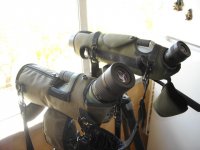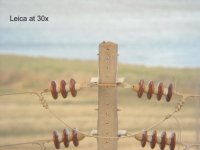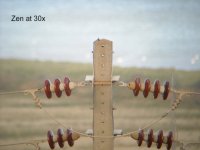I hope Henry doesnt mind, if I share my thoughts about these too scopes, on his thread, I do not consider it a review just a day with lots of fun....
I had previously said that I prefer the Zen ED2 over a 77 APO-Televid Leica that I regularly use for fieldwork. Well… I still do, but after putting for the first time both scopes side by side, the difference between them is not that big as I thought before, I was convinced that the Zen was better on all situations.
In fact, this older “Alpha” beat the new Zen ED2 in some occasions, and different light conditions, but so did the Zen over the Leica. I evaluate them from morning light to late night, with bright sun, overcast weather and almost with no light at all, the Gods had been generous that day.
The 77 Leica is still a fine scope to look through, not as sharp to the edges, as the Zen but with similar flat field and almost as wide field of view. It handles light with bright sun in the way all Leicas do, the view is lovely with warm and contrasting colours from 20x to 60x, however in all situations the view was like seeing through the city smog, when comparing to the Zen ED2, that shows always a crystalline image.
In the morning, the overcast weather gave the lead to the Zen ED2, every bush with flowers and leaves had a sharp, bright colourful 3D view from 20x to 60 x with the Zen, the Leica image was soft and much less contrasting, they seemed totally different scopes in that moment, but in the late afternoon with the sun on my back, the Leica surprised me and the opposite happened, now the contrasting and colourful image was shown through the Leica, and the Zen had difficulty to handle CA from 40x forwards, at least for the Leica standarts.
I have never noticed much CA on the Zen, like I did that afternoon, the Leica had none, like Henry Link stated, we should always have a well corrected scope to keep the reviews unbiased. Leica states that Apochromat-Televid´s have 1 fluoride element, don’t know if pure fluoride or just marketing around the f word.
The Leica star tested better than the Zen, circular concentric rings in both sides of focus, without the impinging prism problem shown by the Zen that originates SA.
To me, resolution is very important, so SA on the Zen is the main reason of dislike, until 40x there is no reason to complain about, but at 50x and 60x, its more difficult to achieve perfect focus with the Zen…sometimes and when mirage is too high you can see the image get from focused to slightly unfocused repeatedly, with the Leica, you get a more stabilized and pleasant image.
At night, the 82mm ED2 is impressive, well-defined images at 20 or 30x, then you push to 60x and you still have plenty of light to see with good resolution: textures of walls, street lamps, tiny plants growing on old roofs, geckos,moths etc. The Leica is much more dim, even at 20x resolution is seriously affected, probably it shows what 77mm aperture scope should, but there is clearly a big diference between them. When I tried to see the concrete texture near a street lamp 200 yards away, it showed a great amount of veil flares, unlike the Zen that as a great ability to deal with them.
In the end of the day I have got the feeling, that I couldn’t decide which one to choose, probably both….or merge them. One to use during cloudy days, dusk, dawn, with the sun in front, and one to use with brigth contrasting hot sunny afternoons with the sun on your back.....
After much thinking and reviewing mentally both scope views, I still prefer the Zen…but makes me wonder how much good the new 82 Leica APO- Televid is.
I´m adding 2 pictures taken at 30x with both scopes where you can see the cold tinge of the Zen versus the "smog" warm tinge of the Leica. Both photos taken with 2 minutes apart and the same settings except ISO, 141 on the Zen and 191 on the Leica.






